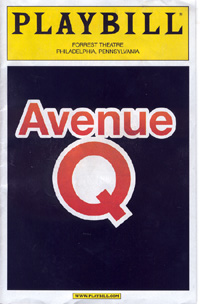Musings
an Online Journal of Sorts
By Alyce Wilson
February 5, 2008 - Visit to Avenue Q
Sunday afternoon, we went to a matinee of Avenue Q at the Forrest Theatre. We went with a group of people but got our tickets separately so that everyone could get the seats they wanted at the range they wanted. The idea was to meet up afterwards and have dinner together.
Before the show, we kept looking for our friends but didn't see them. We found them during intermission, though, and set an exact place to meet afterwards. The group included The Dormouse, who had planned the outing; The White Rabbit; Batman and his roommate; and The Video Editor.
Avenue Q was a sensation when it opened on Broadway a few years ago because of its unique take on the musical genre. The best way to describe it as a grown-up version of Sesame Street.
Clearly, it's written for people, like us, who grew up with the show and now, as youngish adults, are struggling to make their way in the world. So the characters in the play range from about 23 to mid-30s, and they're all living on the eponymous Avenue Q, a low-rent district in an outlying borough of New York City.
Now, just because the play features puppets doesn't make it static. In fact, the puppeteers are also actors, and they walk around the stage, in plain view. Often, their body language informs the characterization. So for example, when the male lead, Princeton, played by Robert McClure, is dancing around, giddily, the puppeteer skips. When McClure plays Rod, a much more tightly wound character, he uses more closed-in body language.
This was particularly evident with the character Lucy the Slut. Because she was played by the same woman who plays the female lead, Kate Monster, played during our performance by Maggie Lakis, sometimes another puppeteer, Minglie Chen, had to fill in, doing the puppetwork while Lakis continued to do the voice. While playing Lucy the Slut, Chen adopted a particularly slinky walk, in keeping with the character.
In addition, a couple actors simply play roles that don't involve puppets, namely the 30-something couple Brian (played at our performance by Cullen R. Titmas) and Christmas Eve (played by Angela Ai). So just as on Sesame Street, there is a mix of real people and puppets, all living together.
Because it's a grown-up show, it deals with such grown-up subjects as job dissatisfaction, unemployment, homelessness, relationships, marriage and ambition. A great example of this is personified by the Bad Idea Bears, these extremely cute colorful teddy bears who urge people to do such things as spend that check from their parents on a case of beer ("it's a savings in the long run") or stay out late drinking the night before an important task at work.
I've been visited by the Bad Idea Bears many times: "Who cares that your landlord says you can't have a puppy? You can hide it!" or how about "Just one more brownie won't make a difference to your waistline! Besides, they're yummy!" and of course, "Don't worry about that strange clanking noise. Your truck will run forever!"
Occasionally, video screens come down to show video along with what's happening on-stage. In one instance, the character Gary Coleman (yes, of Different Strokes fame), played by Carla Renata, sings a jaunty song to teach one of the characters about the term "schadenfreude," which means taking joy in the misery of others.
As silly as it can be at times, the play gets across some serious messages. The song that ends Act One, "There's a Fine Line," is one of the more moving songs I've heard about a failed romance, about how "there's a fine, fine line between love and a waste of time."
Lakis did a great job with her portrayal of Kate Monster, a teacher with a dream of creating a school for monsters, who was alternately cheerful and vulnerable. And McClure was impressive in his dual roles as the Princeton, a directionless college graduate hoping to find purpose, and Rod, an uptight accountant and closeted gay harboring feelings for his happy-go-lucky roommate, Nicky, a relationship clearly patterned on Bert and Ernie from Sesame Street.
One of the funniest performances was by Angela Ai as Christmas Eve, a Japanese immigrant engaged to Brian, the unemployed, aspiring comedian. With her garish fashion sense and thick accent, she could easily be reduced to an ethnic stereotype, but as played by Ai, Christmas Eve is a funny, straight-talking, compassionate woman who finally proves her skills as a counselor (with two master's degrees).
In what could be a thankless role, since it is based entirely on someone we already know, Carla Renata did a stellar job as Gary Coleman, adopting his mannerisms to such a degree that if you couldn't see her braids pulled back under her baseball cap, you'd think it might just be the man himself. I had seen her before on a couple episodes of It's Always Sunny in Philadelphia and on My Name is Earl, and this role proves that she's versatile and that she can sing.
Throughout the play, we're taught such life lessons as "everybody's a little bit racist," that "everybody's a bit dissatisfied," and that "the more you love someone the more you want to kill them." It ends with a song of both acceptance and hope, with the idea that everything happens in your life is just "for now," the implication being that there's always an opportunity to change. Of course, this also allows the funny line, reminiscent of "Always Look on the Bright Side of Life," that "this life can be really scary, but it's only temporary."
The set was simple for this production, consisting of one flat of a city block, with windows that people can appear in. When they need to depict an event that takes place inside, they open doors and have a little background scene which they act in front of. Normally, this works fairly well, but every one in a while it's confusing. Still, it's a fairly efficient way to handle set changes, as the actors themselves open and closed the doors.
They also found creative ways of throwing in a few surprises, which I won't reveal, that involve additional set pieces.
Where we were sitting was in the nosebleed seats, only a few rows from the very back. Aside from the fact that the rows were so close together that The Gryphon had to sit sideways, the view wasn't bad. While we were at a much steeper angle than someone viewing from the floor, we didn't seem that far away from the action, as this camera phone picture shows.
All in all, we enjoyed the performance and gave it a standing ovation. Afterwards, we met our friends out front to discuss where to eat. We tried first a Japanese place nearby, but it didn't open until 5 and it was closer to 4. So we walked into Chinatown and ate at The Gryphon's current favorite, Mixx, where we could get sushi.
During dinner, much of the conversation turned to anime, which didn't really interest me, so I talked to Batman and The Dormouse about our experiences in theater. I was in the pit band for a high school production of The Pajama Game, and when our school stopped staging musicals, I was in the pit band for a local theater production of Annie and then in the chorus for local theater productions of Bye-Bye Birdie and Oklahoma. I have many fun memories, some T-shirts and lots of pictures from those productions.
The Dormouse has been in a number of productions, including The Mystery of Edwin Drood, Assassins and Godspell. Batman's primary connection to theater was serving as the high school photographer who documented the school productions.
Afterwards, The Gryphon was headed for his weekly meeting of Philadelphia Area Game Enthusists (PAGE), so we walked with The Dormouse to the lot where he was parked, and The Dormouse dropped off The Gryphon at his meeting and then drove me back to the train station where I'd left my car.
We all had a really nice time, and I'm glad we went. It was definitely not a waste of time!
Moral:
Even adults have something to learn.
Copyright
2008 by Alyce Wilson
What
do you think? Share your thoughts
at Alyce's message board (left button):
![]()
![]()



